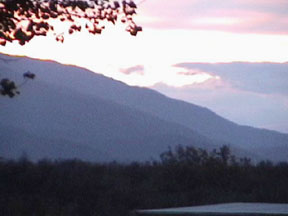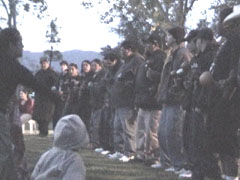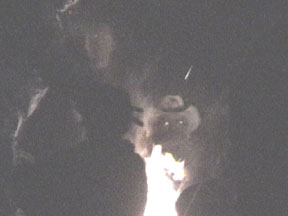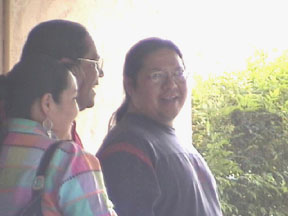Cupa Centennial
2003
By Roy Cook
Photos: Ben Nance
The Pala tribe hosted a public fiesta from 2 to 9 p.m. May 2,1003 at the traditional village of Cupa, (Warnerís Spring resort on state Route 79 northeast of Lake Henshaw). The Cupa Village along with Wilakal and Matagui has been significant from earliest times.
 This
valley is directly on the most traveled route from the Colorado River
to the Los Angeles basin and all the tribal villages there. Long before
any European contact this valley is an example of the respectful nature
of tribal people living together. Completely different language groups
living within sight of each other and yet not imposing their will on another.
Indian singing, dancing and food are an important part of many public
celebrations.
This
valley is directly on the most traveled route from the Colorado River
to the Los Angeles basin and all the tribal villages there. Long before
any European contact this valley is an example of the respectful nature
of tribal people living together. Completely different language groups
living within sight of each other and yet not imposing their will on another.
Indian singing, dancing and food are an important part of many public
celebrations.

Singerís voices again move and weave in the traditional Village of Cupa. Singers were invited from Southern California and Arizona to participate in singing the world into being with the song cycle tradition of the people.
Many Peon games have been held from earliest times. Times may change and
economic situations differ but Tribal people keep their custom and tradition
alive. Ironically, gaming is once again bringing the people together for
this cultural celebration.


With funds from its casino the eight hundred member Pala Band hosted the
centennial by renting a 41-unit block of Warner Springs Ranch resort.
The duplexes include 17 adobe cottages that Cupa people occupied until
1903. More than 200 tribal members were expected.
 Pala
Vice Chairman, Leroy Miranda, who directs the tribe's Cupa Cultural Center,
has done extensive research on the relocation. Miranda's great-grandmother,
Rosinda Nolasquez, was the last survivor of the expulsion. She died in
1987 at age 94 and is buried in the small Cupa cemetery at Warner Springs.
The return to Warner Springs was Miranda's idea. In an interview with
Chet Barfield he said, "The reason we did it is so our people can remember
where they came from. We want this to be an awakening and a curing of
a tragic time in our history."
Pala
Vice Chairman, Leroy Miranda, who directs the tribe's Cupa Cultural Center,
has done extensive research on the relocation. Miranda's great-grandmother,
Rosinda Nolasquez, was the last survivor of the expulsion. She died in
1987 at age 94 and is buried in the small Cupa cemetery at Warner Springs.
The return to Warner Springs was Miranda's idea. In an interview with
Chet Barfield he said, "The reason we did it is so our people can remember
where they came from. We want this to be an awakening and a curing of
a tragic time in our history."
Using his own research, Miranda was able to place tribal members in the
original locations of their lineal ancestors. The dwellings have original
thick adobe walls and open-beam ceilings. They are upgraded with electricity
and plumbing.
Pala Chairman Robert Smith, who is staying with his wife and children
in a three-room home that was his great-great-grandfather's said, "It's
a major event for the tribe. It's a good feeling to come back here. Words
can't explain it." Cupa members held a memorial service at the adjacent
cemetery where many of their relatives are buried.

Public festivities culminated at the annual Cupa Days Celebration on the
Pala reservation on state Route 76.
AmericanIndianSource.com
WebMaster: Ben
Nance